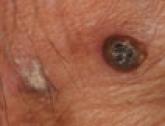Squamous cell carcinoma (SCC) on sun-exposed sites following prolonged immunosuppression is one of the main long-term complications of allogeneic transplantations. In an article published in the Journal of Clinical Investigation (2013;123:3797-3801), the investigators demonstrated that the SCC tumor cells from a renal transplant patient had the donor genotype and harbored a TP53 (tumor-suppressing p53) mutation in codon 175; in addition, the same TP53 mutation had previously been documented 7 years earlier in p53+ cells in the renal tubules from a kidney graft biopsy. The observations in this patient provide evidence that the kidney donor can contribute to subsequent SCCs in renal transplant recipients.
What’s the issue?
Donor contribution to the malignant epithelium of cutaneous cancer in organ transplant recipients has several important implications. First, this observation provides additional insight into the initiation and progression of tumor carcinogenesis. Second, because there is longer survival of patients following renal transplant and therefore a prolonged duration of immunosuppression in these individuals, the development of long-term complications such as SCC of sun-exposed skin may be greater. Third, should genetic profiling of kidneys from potential donors to screen for cancer-associated mutations be performed? And fourth, is this phenomenon restricted only to patients receiving kidneys or might it be a possible complication in the recipients of other organs such as hearts, lungs, or even faces?
We want to know your views! Tell us what you think.



